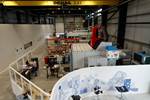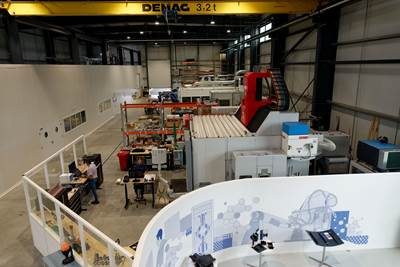CNT-enhanced prepregs: commercial & production-capable
N12 Technologies’ NanoStitch and Surface Layer System (SLS) products are part of a new generation of nanomaterials aimed at delivering macro-level benefits in products produced at commercial scale.
Carbon nanotubes. They’ve have been around for 20 years, with attempts at commercialization for a decade. But until now, says Dr. Ryan Williams, senior scientist for N12 Technologies (Cambridge, MA, US), “companies have not seen the performance or scale promised.” Selected as a 2015 Top Start-up by the Silicon Valley-based non-profit TIE50 global annual awards program, Williams’ Massachusetts Institute of Technology (MIT, Cambridge, MA, US) spin-off firm aims to change that. “Our goal is to make sure our technology delivers on its promise,” he says.
N12 Technologies’ NanoStitch and Surface Layer System (SLS) products are part of a new generation of nanomaterials aimed at delivering macro-level benefits in products produced at commercial scale. N12 also focuses on the reinforcement, rather than the
resin. Mixing CNTs into resin has presented real challenges, Williams claims, both to performance and part production scale up, because CNTs agglomerate, hindering optimal dispersion and orientation.
“We put vertically aligned carbon nanotubes (VACNTs) at the interface of each lami- nate ply and align them so that the user doesn’t have to do this,” Williams explains, giving the analogy of chopped carbon fiber vs. unidirectional prepreg. “You need not only the nanomaterial, but also placement and alignment in order to achieve high performance and light weight,” he says. “We do this at the nano scale, but with a completely drop-in product. We don’t expect the composites industry to modify its methods to use our products.”
Williams says that users can roll, cut and handle N12 NanoStitch prepreg during layup or on an automated tape laying machine just like other prepregs. Further N12 has, he says, “capacity now to deliver thousands of square meters of NanoStitch materials per year and have completed another round of financing to expand this capacity to millions of square meters within the next 3-4 years.” N12 has commissioned a production-rate reactor for the aligned CNTs and has a plan for scaling production at reasonable cost to support expanded industrial-scale supply.
“We are working with a number of the large prepreg manufacturers to deliver NanoStitch-enhanced products — basically the prepregs already widely used in the industry — but with NanoStitch applied,” Williams explains. “We are also devel- oping a resin film delivery strategy, which gives the industry design freedom in what they do with the technology.” For example, some companies want to apply the NanoStitch globally, while others want to locally reinforce a line of rivet holes or in a particular spot on a golf club shaft.
N12 also aims to be as close to cost-neutral as possible. He explains, “For example, if you have a 64-ply laminate to meet performance requirements, our NanoStitch technol- ogy might achieve a 10% weight savings by boosting the performance, which then balances the additional cost of adding in the technology.” He says the company has worked mostly with epoxies but also with phenolics, bis- maleimide and thermoplastics. It is already testing products with dozens of companies and has more than 100 different relationships established with potential customers, some in the very initial stages and others in physical component testing.
Related Content
HydroGraph ramps up efforts to scale pristine graphene offerings
Purchase orders for autocomposite improvement program, patent application filings and additional certifications push the graphene producer on its path forward to commercialization for composites, coatings and lubricants, to name a few.
Read MoreLouisiana graphene startup reports R&D partnership, test results
TMTP’s graphene is reported to improve the tensile strength of epoxy by more than 400%, produced via a scalable, low-energy process. The company is targeting applications in composites, plastics and 3D printing.
Read MoreAMD to open U.S. subsidiary for defense, aerospace nanotechnology
AMD Inc., based in Austin, Texas, has a broad license to all parent company IP and will continue to invest in R&D projects with the group’s existing university partners.
Read MoreHydroGraph collaboration to demonstrate pristine graphene’s support of synthetic fiber materials
Technical partnership with large global synthetic fiber manufacturer will evaluate the impact of HydroGraph’s graphene on critical fiber performance attributes.
Read MoreRead Next
Composites end markets: New space (2025)
Composite materials — with their unmatched strength-to-weight ratio, durability in extreme environments and design versatility — are at the heart of innovations in satellites, propulsion systems and lunar exploration vehicles, propelling the space economy toward a $1.8 trillion future.
Read MorePlant tour: Daher Shap’in TechCenter and composites production plant, Saint-Aignan-de-Grandlieu, France
Co-located R&D and production advance OOA thermosets, thermoplastics, welding, recycling and digital technologies for faster processing and certification of lighter, more sustainable composites.
Read MoreAssembling the Multifunctional Fuselage Demonstrator: The final welds
Building the all-thermoplastic composite fuselage demonstrator comes to an end with continuous ultrasonic welding of the RH longitudinal fuselage joint and resistance welding for coupling of the fuselage frames across the upper and lower halves.
Read More













